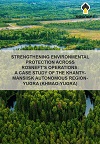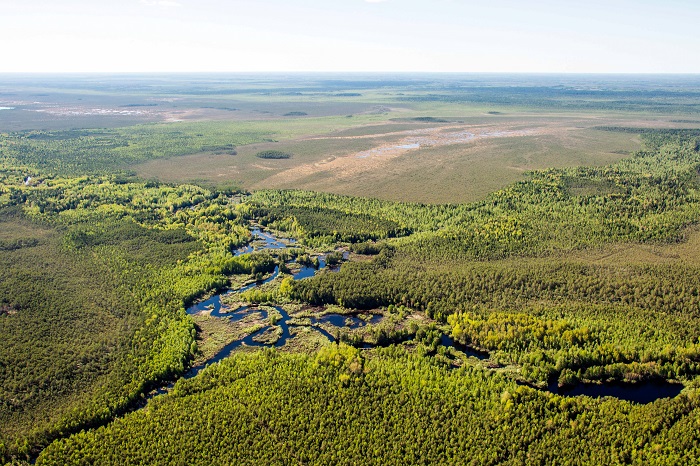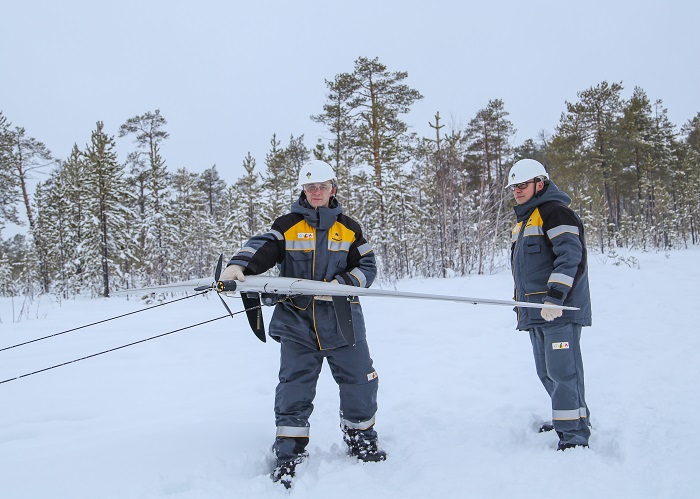Please activate JavaScript in your browser to use all interface options.
 |
Strengthening environmental protection across Rosneft’s operations: a case study of the Khanty-Mansiisk Autonomous Region-Yugra (KHMAO-YUGRA) |
Rosneft’s core activities are guided by the UN Sustainable Development Goals
OUR COMMITMENT
In its day-to-day activities and operations, Rosneft is guided by the principles of corporate responsibility built on the corporate Rosneft-2022 strategy.
As a member of the UN Global Compact for the past 10 years, the company has committed to meeting the UN Sustainable Development Goals, 5 of which have been prioritized.
SDG 3 ‘Good Health and Well-Being’ is one of these prioritized goals and within Rosneft’s operations this goal covers a number of environmental and social commitments.
The Rosneft-2022 Strategy targets first quartile HSE performance on core HSE metrics by 2022 with management reviews of annual key performance indicators (KPIs) and the Сompany’s “green” investments projected to reach RUB 300 bln between 2018-2022.
Rosneft management have key environment and safety indicators as part of their annual performance assessment
The Khanty-Mansiisk autonomous region - Yugra - Rosneft's strategic priority

KhMAO-Yugra accounts for about 50% of Rosneft’s hydrocarbon output
Rosneft produces about 50% of the KhMAO-Yugra hydrocarbons, almost twice as much as the next peer company*
*Footnote: the Company's data includes the share in affiliates / joint ventures.
Sources: Company data, the Report of KhMAO-Yugra Governor.
Coordination with Regulatory Agencies
The Company subsidiaries in the region maintain an ongoing contact with the local environmental supervision organization, the Agency for control and supervision in the area of forestry affairs and flora and fauna protection (Prirodnadzor) of KhMAO-Yugra. In these meetings environment protection plans, and the annual nature protection and renewal programmes are communicated. Other topics under discussion typically include compliance with legislation as well as land remediation inspection results.
In 2018 - 2019, over 36 bln RUB was invested by Rosneft in nature protection and renewal of KhMAO-Yugra assets (capital and operating expense).

This represented more than 24% of Rosneft’s 2019 investment in nature protection and renewal.
In its approach, Rosneft has committed both to remediation of the accumulated contaminated land as well to develop a pipeline integrity system to reduce new leaks, improved reporting and response system to minimize spill quantity, as well as improved waste management processes at a number of sites.
Continued land remediation
Each year on average Rosneft remediates a significant 400-500 hectares at the Company’s license areas in KhMAO-Yugra.

In 2019, the Company remediated over 809 hectares of land in KhMAO-Yugra, of which 763.4 were officially inspected and removed from the impacted land register.
Land remediation makes the land fit for future use with an emphasis on restoring the fertile soil, through soil amelioration processes, and improving the ecosystem productivity in accordance with legal requirements. Rosneft has been consistently increasing its land remediation efforts through the implementation of a corporate Programme to eliminate legacy environmental impacts from contamination.
Legal requirements and external verification
The documents governing remediation of these sites include Regulation of the KhMAO-Yugra Government No. 466-p dated 10.12.2004 - Approval of the regional standard “Permissible residual oil and oil products content in the soil after remediation and other restoration activities in the Khanty-Mansiisk autonomous region – Yugra”, as well as the approved design documentation.
State inspection of the remediated land is carried out in compliance with Regulation of KhMAO-Yugra Government No. 276-p dated 29.07.2016 – “The procedure for inspecting remediated land that was earlier contaminated with a view to excluding it from the register of territories and water bodies contaminated with oil, oil products and bottom water in the Khanty-Mansiisk autonomous region – Yugra”.
In 2015, the Federal State Unitary Enterprise “Aerogeologia” made a large-scale inventory of impacted land at the Company license areas in KhMAO-Yugra using aerial and satellite high and ultra-high resolution images to update the information on the extent of legacy contamination that was required to be remediated.
After inspectors from KhMAO-Yugra Prirodnadzor examine the remediated land, they make a decision on whether it should be excluded from the related register for the Khanty-Mansiisk autonomous region - Yugra.
A number of Company subsidiaries in the region including Nizhnevartovsk gas producing enterprise and Varyoganneftegas, have already successfully achieved 100% legacy remediation.
RN-Yuganskneftegas: Applying advanced technology and modern management systems to promote environmental protection

RN-Yuganskneftegas is Rosneft’s largest producing asset with a production of 69.5 mln tonnes of crude oil (over 1.4 mln b/d) in 2019. This represents about 30% of the total KhMAO-Yugra crude oil production, and as a comparison is similar to the size of Angola’s* oil output. The subsidiary develops 37 license areas in KhMAO-Yugra with the total acreage of over 21,000 sq.km.
*Source: BP Statistical Review of World Energy 2019, p. 17
Crude oil production at the oil fields currently developed by RN-Yuganskneftegas started as early as in 1961 which has led to accumulation of legacy disturbed lands in the subsidiary’s license areas.
In 2018 - 2019, RN-Yuganskneftegas spent over RUB 15 bln on nature protection and renewal while over the past ten years, the Company spent RUB 7.8 bln on land remediation in the region..
RN-Yuganskneftegas plans to spend approx. RUB 10 bln between 2019-2024 on land remediation, exceeding the prior spend more than threefold.
Technology, response and innovation for remediation in harsh environments
Applying the latest technologies helps the Company to improve the quality of information regarding the soil condition at its license areas. One such area of technology is a corporate Geo-information system (CGIS) which is used for environmental monitoring and reporting. The inventory of oil-contaminated soil has been developed by interpreting the aerial imaging data followed by ground observations of the identified land plots.
This enables RN-Yugansneftegas to monitor the land condition and accumulation of contaminated land plots which is then reported to KhMAO-Yugra Prirodnadzor.
Despite the harsh northern climate, Company subsidiaries carry out environmental renovation all year round, having the necessary technologies and special-purpose vehicles at their disposal.
Winter remediation is a particularly effective way of reclaiming disturbed land in KhMAO-Yugra. The region is abundant in water and swamps, which makes winter remediation ideal for reclaiming the areas that are inaccessible in warmer weather conditions. Winter remediation includes a range of preparatory and technical activities, such as determining points of access for vehicles, mapping land plot boundaries, building access ways and pipeline crossings as required, and restricting the disturbed area, as well as clearing away the waste and cleaning the soil.

Remediation activities are supported by the use of most advanced special-purpose vehicles such as swamp excavators, large tonnage and mini cross-country vehicles, amphibian swamp buggies, and snow tractors.
Environmental rehabilitation helping to maintain the regional biodiversity
In 2019, in support of artificial reproduction of aquatic biological resources, RN-Yuganskneftegas released almost 9 million fingerlings of valuable fish species (Siberian sturgeon, pelyad and muksun), setting a record among the regional enterprises with commendation from the head of Russia’s Federal Fishery Agency.
Increasing pipeline reliability
The total length of Rosneft’s operating field pipelines in KhMAO-Yugra exceeds 26.8 thousand kilometres which represents about 32% of the total length of the Company’s regional field pipelines.
The Company has been implementing a large-scale Programme on increasing pipeline reliability which includes modernization, capital repairs and maintenance.
The Programme on increasing pipeline reliability resulted in over RUB 23 bln invested in Rosneft field pipelines in 2019. Improvements in pipeline integrity and reliability was RUB 9.6 bln of this figure while operating expense was over RUB 13.4 bln.
Rosneft improves the operating reliability of pipelines by conducting pipeline diagnostics to detect pipeline corrosion at early stages so that corrective action can be taken.
Corrosion inhibitors are also used to develop a protective layer on the inner metal surface to reduce the rate of corrosion. The Company cleans the internal pipelines surfaces through pigging operations to maintain the pipeline throughput capacity and prevent creation of no flow areas and sediment accumulation, which can lead to internal corrosion.
Last year the Company completed implementation of the 2015-2019 Programme on increasing pipeline reliability and achieved the target of reducing pipeline failure rate by 30% as compared to the 2013 baseline.

In 2020, we launched a new large-scale 2020-2025 Programme on increasing pipeline reliability covering 28 oil and gas producing subsidiaries. Under this Programme, we will apply the risk-oriented approach and prioritize projects depending on their potential environmental footprint.
The key goals of the Programme for 2020-2025 include:
- Reducing the pipeline failure rate by over 20% compared with 2019
- Increasing the amount of pigging diagnostics for better pipeline controls
- Selecting, testing and introducing new technologies and materials to increase protection against reduce corrosion and sediment build-up
- Developing and applying improved operating pipeline controls
The 2020-2025 pipeline integrity Programme plans to modernize 10 thousand km of pipeline and conduct capital repairs and maintenance on 7 thousand km pipeline.
In 2019, across the KhMAO-Yugra operations the Company strengthened pipeline reliability actions by:
- Assessment of the technical compliance and integrity of 8.5 thousand km of pipeline (which was 12.5% higher as compared to 2018)
- Protection of over 8.0 thousand km field pipelines with corrosion inhibitor (an increase of almost 600 km year-on-year)
- Upgrading and repair of almost 844 km of pipelines
In 2019, both the pipeline failure rate and the unit pipeline failure rate in KhMAO-Yugra were reduced by 14.6%, and 17.4% respectively over the previous year.
Overall, the Company’s expenditure on increasing pipeline reliability (capital and operating expense) in KhMAO-Yugra in 2019 amounted to about RUB 11.8 bln, or about 51% of the total Rosneft spend.
RN-Yuganskneftegas has established its own emergency response units dealing with oil spill incidents and land remediation, with quality management effectively controlled by an in-house remediation supervisor team. As a result, in the last three years, the volume of disturbed land at RN-Yuganskneftegas license areas reduced by over 17%.
Technology and Innovation for improving pipeline reliability
Accelerated technological development and digitalization of all Company activities are an important component of Rosneft-2022 Strategy. In the area of improved pipeline reliability, an innovative project is planned which will result in applying AI (Artificial Intelligence) technology to monitor and manage pipeline technical compliance.
Project completion and pilot testing are scheduled for 2022. The new technology should be applied from the well to the delivery-acceptance point and will be used across Company subsidiaries.
Pioneering drone application at Samotlorneftegas

- The goal of the project was to ensure ongoing around-the-clock drone monitoring of the field pipelines, as well as the whole of the Samotlor infrastructure.
- The advantages of drone application are related to its efficiency where detected problems are reported online to the dispatch unit; safety (pipeline monitoring in remote and practically inaccessible places and ability to operate in challenging conditions (at night and in poor visibility).
- First pilot testing took place in the second half of 2010 with the aircraft monitoring system commissioned into pilot operation in April, 2012.
- There are now 21 routes for regular drone flights. Video pipeline monitoring takes place during the day and at night, and at air temperatures ranging from minus 35 to plus 40 degrees Celsius, as well as in rainy, misty or foggy weather.

-315xx70.png)

